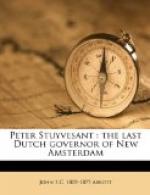A strong well-armed party of one hundred and sixty-four soldiers set out on this expedition. Forty six of these were friendly Indians from a tribe called Marespincks, whose home was on Long Island. The soldiers were familiar with the route which they had so recently traversed. A weary but rapid march of twenty hours brought them to the scene of their recent victory. Not an Indian was there. All was silence and awful desolation. Even the colonists were appalled by the spectacle which opened before them. The Indians were so thoroughly panic stricken that they had not ventured back even to bury their dead. The decaying corpses lay scattered around, many of them half consumed by vultures and wolves. The birds and beasts, with wild cries, were devouring their prey. Parties were sent out to scour the woods. But no signs of the savages could be found. In fact the Esopus tribe was no more. It was afterwards ascertained that the wretched remnant had fled south and were finally blended and lost among the Minnisincks and other southern tribes.
The fort was so strong that it required not a little labor to destroy it. It was necessary to cut down or dig up the palisades, which were composed of trunks of trees twenty feet long and eighteen inches in diameter. Several cornfields were found in the vicinity wherever an opening in the forest and fertile soil invited the labor of the indolent Indian. Two days were occupied in cutting down the corn, already beautiful in its golden ripeness, and in casting the treasure into the creek. The palisades were then piled around the dwellings and in a few hours nothing remained of the once imposing fortress but smoking embers.
This Indian fort or castle, it is said, stood on the banks of what is now called the Shawangunk kill, in the town of the same name, at the southwestern extremity of Ulster county. It seems as though it were the doom of armies on the march, ever to encounter floods of rain. Scarcely had the troops commenced their return ere the windows of heaven seemed to be opened and the fountains of the great deep to be broken up.
At ten o’clock on the morning of the 5th of October, 1664, the march was commenced. The rain came on like that of Noah’s deluge. The short afternoon passed away as, threading ravines and climbing mountains, they breasted the flood and the gale. The drenched host was soon enveloped in the gloom of a long, dark, stormy night. Weary and shelterless, the only couch they could find was the dripping sod, the only canopy, the weeping skies. The weeping skies! yes, nature seemed to weep and mourn over the crimes of a lost race,—over man’s inhumanity to man. It was not until the evening of the next day, the rain still continuing, that these weary soldiers reached their home at Esopus.
CHAPTER XII.
ENCROACHMENTS OF THE ENGLISH.




